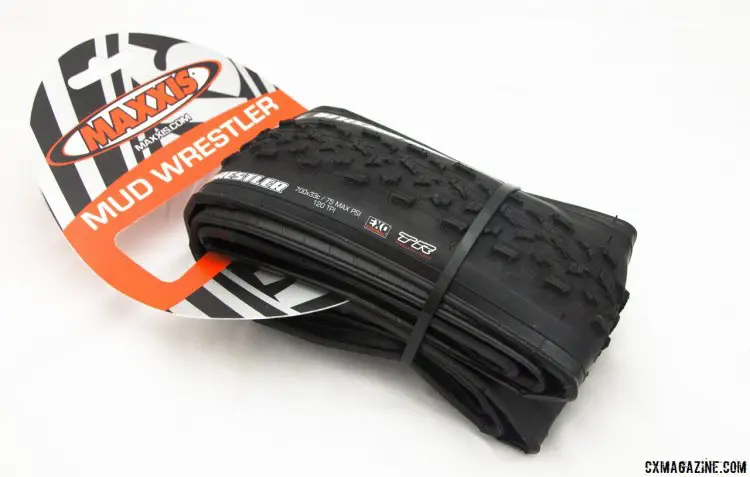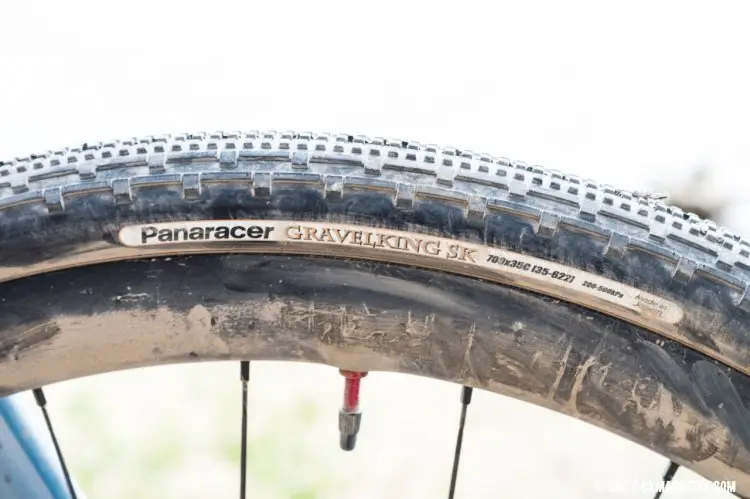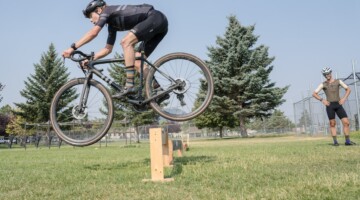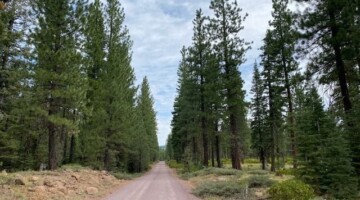While drop bar riders have traversed dirt, fire roads, gravel and more since well before the birth of the gravel bike, interest in the road less traveled has spawned an increasing number of gravel-specific products including tires. This is all the more true as tubeless technology has taken a firm grasp of all manner of off-road riding.
But specific equipment and new ways of mounting rubber isn’t a failsafe against all measure of misfortune and even the best tire set-up can suffer problems, like a cut sidewall. So some of us here at the Cyclocross Magazine offices started wondering:
What’s the best way to avoid cutting a tire on a gravel ride? Is the answer higher or lower pressure, or something else?
“Protect the tire” was Carl Decker’s mantra, as he said during our interview, and it might have helped him win the 2016 Lost and Found gravel race. But racers cut tires left and right, and it wasn’t clear that high pressure was key to avoid tire cuts from the sharp Sierra Nevada rocks embedded in the fire and gravel roads.
So we went to the experts, tire manufacturers, to find out. We reached out to a number of tire companies and heard back from Maxxis Tires, Challenge Tires, Panaracer and WTB. And what we learned was interesting but certainly didn’t reveal consensus.

Miles and miles of riding to the horizon. Proper equipment set up smartly is critical for making it to the finish. 2016 Lost and Found Gravel Race. © Cyclocross Magazine
What’s Your Tire Made Of?
“Gravel is a really interesting predicament,” said Bobby Brown from Maxxis Tires. “Cutting tires isn’t normally a function of pressure as much as it is casing strength and added protection. Lightweight, higher TPI casings are more fragile and easier to cut. But most buyers want the lightest weight,” he added.
“Gravel racing really seems to require full bead-to-bead protection as the sidewalls can get cut at lower pressures and the tread is exposed to countless sharp edged pebbles,” added Brown. “You can run harder rubber that resists cutting but then you lose rolling efficiency and comfort while gaining weight,” he said. “Pressure isn’t as important as the tire’s construction,” said Brown, who added that:
“In general I’d advise to get a tire with a stout enough casing and appropriate tread and sidewall protection for your terrain and then use your air pressure to fine tune ride quality, handling, and rolling efficiency.”

The New 40c Maxxis Rambler looks to have a bit more aggressive tread for mixed terrain riding. NAHBS 2016. © Cyclocross Magazine
The folks at Challenge Tires also recognize that tire construction is a key factor. “With handmade tires, you could use vinegar to harden a very thin portion on the outside layer of the tread preventing some cuts with little affect to the tread’s flexibility,” noted Chris Clinton, who went on to say that the “tire’s suppleness is also important. Higher thread count tires and more flexible treads improve the tire’s ability to absorb the impact and flex around the object versus bouncing over the object. This is the same whether on gravel or paved roads which might have cracks, seams and small bits of gravel.”
This is interesting in that it seems to be the opposite take from Maxxis regarding higher versus lower TPI tires.
When asked if tubeless technology would save us all, Brown noted the reality that “[s]ome say Tubeless Ready technology is added protection but it ultimately is the final defense against leaving you stranded on the side of the road.”
Goldilocks Air: Not Too High, Not Too Low
Brown from Maxxis told us that what they’ve found, particularly when it comes to MTBs, is that:
“lower pressures expose more sidewall to cuts. Trends towards wider rims are exposing more tire sidewalls to rocks too, sometimes before the sideknobs would hit. This is a big reason why our gravel tires either have sidewall protection via EXO inserts or bead-to-bead protection via our Silkshield breaker.”
Brown did add that “[l]ower pressures may [also] bottom out on the rim, pinch flatting the tube or tire casing, but higher pressures do not add protection against cuts. Lower pressures will, however, expose more of the sidewall to gravel by flattening out the tread,” before making sure to note that Maxxis’ “Mud Wrestler CX tire also has EXO sidewalls since you never know what you’ll run into in a deep enough mud-hole.” Interesting, and a good note of caution.

Maxxis Mud Wrestler tubeless cyclocross tire is one that offers added protection. © Cyclocross Magazine
On the flip side, Challenge Tires’ Chris Clinton advocates running lower pressure to avoid cuts:
“When looking to avoid cutting tires in rockier/rougher gravel rides and races, we at Challenge feel the better tactic is to run a reasonably low tire pressure.”
“More pressure leads to a harder tire which has a higher chance of cutting. The harder tire tends to slip off of rocks or force the rocks out from under the tire. As this occurs, there is a good chance that the movement between the two items can lead to the rock cutting the tire. A harder tire also tends to bounce over gravel and the landing could be on top of a sharp rock leading to tire damage. Higher pressure will make the tire fight the rock and in this battle the rock will always win,” said Clinton.
Clinton when on to explain that “[a]t lower pressures, the tire will tend to distort and absorb the shape of the rock while it rolls over the gravel. Thus there is less slipping and bouncing and a lower likelihood of a cut occurring. However, at too low of pressure it is possible to squeeze the tire’s casing between the rim and a rock which could also cause damage to the tire,” he cautioned.

Lost and Found winner Robin Farina ran the Panaracer Gravel King SK tubeless 35mm tire on Stan’s NoTubes Avion rims. 2016 Lost & Found. ©️ Clifford Lee / Cyclocross Magazine
Panaracer clearly suggests the Goldilocks approach. Jeff Zell with the company says it all depends on the conditions at hand. “There is no one answer to the question because there [are] so many kinds of gravel and rock out there. If you’e talking [about] something you find in the flint hills of Kansas, lower pressures and setting up your tires tubeless is critical. If you’re talking lot’s of baby heads and round, larger stones that my not be sharp, then slightly higher PSI so you [aren’t] crunching the rim on a hard impact. For loose, small gravel perhaps a little higher depending, again, on the shape of the gravel, the overall road conditions and weather. Overall for races with rocky, sharp conditions, lower PSI’s and tubeless are they way to go.”
And Clayton Wangbichler from WTB sounded the same it-depends note:
“There are a few ways to approach this,” he said “but the end result is … [i]t really depends on the situation, the tire involved and the terrain involved. Whether it is a sharp or round rock you’re smashing into. To what extent you are over or under inflating the tires. These, and many more factors, must all be taken into account.”

One of WTB’s newest gravel tires, the Riddler, comes in a wide 45mm width and should prove good for rougher gravel rides. © Clifford Lee / Cyclocross Magazine
Wangbichler added that the “most widely followed way to look at it [is that] increased pressure will aid in deflection of rocks and other objects of ill-intent. Increased pressure will also prevent the tire from rolling as much and therefore leave sidewall less exposed. The [other] way to look at it [is] hold a piece of paper at one end, then hit it with a butter knife. It probably didn’t penetrate and instead conformed around the knife. Hold the paper taut, from both ends, and the knife will likely slice right through it. This way of looking at it could encourage riders to run less pressure in their tires.”
The Final Verdict
Clinton from Challenge was ultimately pragmatic, noting that “[t]he optimal pressure will take into account the rider’s body weight, the tire’s flexibility, the terrain and the rider’s comfort level,” before adding “even with all this fine tuning, there is still a bit of luck involved as we are talking about riding over thousands of little razor blades and jagged marbles. A lower tire pressure will give you a strong stance in the tire/rock battle. Being prepared for the potential flat will keep you rolling.”
And WTB’s Wangbichler exchoed the sentiment. “My suggest[ion] [is to] adjust your tire pressure according to the personal ride quality you’re looking for. Mount durable tires and then use them at pressures that are appropriate for the ride at hand. Tires inflated to the proper pressure will increase control and therefore also produce a faster ride.”
It’s clear that it’s still early days in terms of research and consensus in terms of how to approach a mixed terrain race, especially one with sharp rocks. Perhaps gravel racing is really the Wild West of bicycle racing. Our best advice? Use a tire pressure that will keep you upright, and also get you to the finish line. And yes, we know, seeing what that pressure should be for you at a specific event? That’s as clear as mud.
Have a Wednesday Wondering of your own? Fill out the form below and maybe we’ll answer your question online or in a future print issue.




























